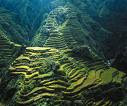:::::::::::::::::::::::::::::::::::::::::::::::::::::::::::::::::::::::::::::::::::::::::::::::::::::
PHILIPPINES SAIJIKI
:::::::::::::::::::::::::::::::::::::::::::::::::::::::::::::::::::::::::::::::::::::::::::::::::::::
Rice
***** Location: Philippines
***** Season: Non-seasonal Topic
***** Category: Plant / Humanity
*****************************
Explanation
In The Philippines, rice is the staple food, and there are many words for it.
bigas - newly-harvested rice grains
punla - rice saplings
kanin - plain cooked rice
sinangag - fried rice
bahaw - cold rice, often the leftovers in the pot, still yummy for the next meal, or if you're feeling hungry at any time and don't have time to cook; just make some sinangag from it or put it in a bowl with very hot soup like bulalo or tinola or nilaga
tutong - burnt rice, brown, found stuck to the bottom of the cooking pot; often no longer good for consumption, unless you're so hungry you might not care
lugaw - gruel, as a basis for soup or to make eating easier for toothless people
Many people like to eat tapsilog = tapa-sinangag-itlog = salted beef, fried rice, an egg (usually fried). This is a favourite breakfast for many, and one I make sure to eat whenever I visit. There are many variations, like longsilog - sausage, rice, egg.
Ella Wagemakers
. . . CLICK here for TapSilog Photos !
:::::::::::::::::::::::::::::::::::::::::::::::::::::::::::::::::::::::::::::::::::::::::::::::::::::

quote
Rice production in the Philippines is important to the food supply in the country and economy.
Rice is the most important food crop, a staple food in most of the country. It is produced extensively in Luzon, the Western Visayas, Southern Mindanao, and Central Mindanao.
In 1989 nearly 9.5 billion tons of palay were produced. In 1990 palay accounted for 27 percent of value added in agriculture and 3.5 percent of GNP. Per hectare yields have generally been low in comparison with other Asian countries. Since the mid-1960s, however, yields have increased substantially as a result of the cultivation of high-yielding varieties developed in the mid-1960s at the International Rice Research Institute located in the Philippines. The proportion of "miracle" rice in total output rose from zero in 1965-66 to 81 percent in 1981-82. Average productivity increased to 2.3 tons per hectare (2.8 tons on irrigated farms) by 1983. By the late 1970s, the country had changed from a net importer to a net exporter of rice, albeit on a small scale.
This "green revolution" was accompanied by an expanded use of chemical inputs. Total fertilizer consumption rose from 668 tons in 1976 to 1,222 tons in 1988, an increase of more than 80 percent. To stimulate productivity, the government also undertook a major expansion of the nation's irrigation system. The area under irrigation grew from under 500,000 hectares in the mid-1960s to 1.5 million hectares in 1988, almost half of the potentially irrigable land.
© More in the WIKIPEDIA !
*****************************
Worldwide use
Japan
..... Rice plants (ine).
A list of kigo.
Rice Dishes from Japan
WASHOKU
*****************************
Things found on the way
*****************************
HAIKU
pot of rice
our cook asks me
how my day went
I have fond memories of our housekeeper, Anday, who was like a mother to me. Everytime I was down (which was often), she would whiff up a plate of fried rice, Hormel hotdogs, a fried egg, and fresh slices of tomato. They are, in fact, my fondest memories of the house I grew up in.
© Ella Wagemakers, October 2009
*****************************
Related words
..... Rice plants (ine) Japan. A list of kigo.
***** PHILIPPINES SAIJIKI
:::::::::::::::::::::::::::::::::::::::::::::::::::::::::::::::::::::::::::::::::::::::::::::::::::
Back to the Worldkigo Index
http://worldkigodatabase.blogspot.com/
:::::::::::::::::::::::::::::::::::::::::::::::::::::::::::::::::::::::::::::::::::::::::::::::::::::





1 comment:
What a service you are providing, exposing so many of us inhabiting parts of the world beside Japan kigos that are indigenous to our areas and valid for haiku.
RDW
Post a Comment